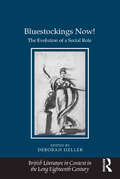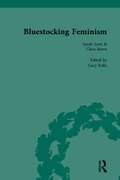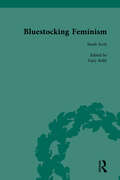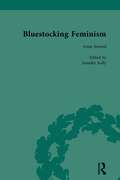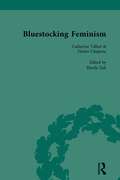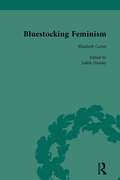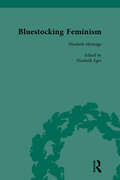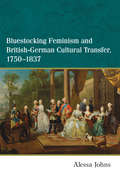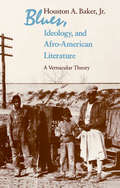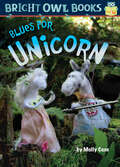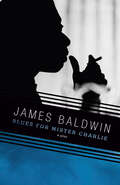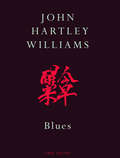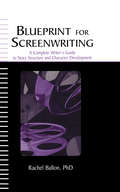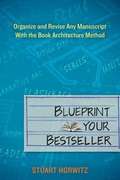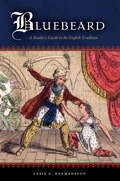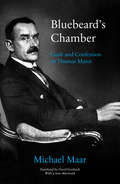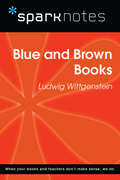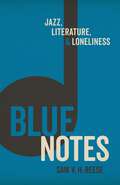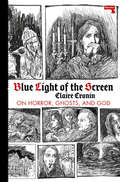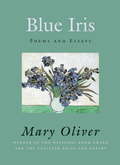- Table View
- List View
Bluestockings Now!: The Evolution of a Social Role (British Literature in Context in the Long Eighteenth Century)
by Deborah HellerBringing together top specialists in the field, this edited volume challenges the theory that the eighteenth-century British intellectual women known as the Bluestockings were an isolated phenomenon spanning the period from the 1750s through the 1790s. On the contrary, the contributors suggest, the Bluestockings can be conceptualized as belonging to a chain of interconnected networks, taking their origin at a threshold moment in print media and communications development and extending into the present. The collection begins with a definition of the Bluestockings as a social role rather than a fixed group, a movement rather than a static phenomenon, an evolving dynamic reaching into our late-modern era. Essays include a rare transcript of a Bluestocking conversation; new, previously unknown Bluestockings brought to light for the first time; and descriptions of Bluestocking activity in the realms of natural history, arts and crafts, theatre, industry, travel, and international connections. The concluding essay argues that the Blues reimagined and practiced women’s work in ways that adapted to and altered the course of modernity, decisively putting a female imprint on economic, social, and cultural modernization. Demonstrating how the role of the Bluestocking has evolved through different historical configurations yet has structurally remained the same, the collection traces the influence of the Blues on the Romantic Period through the nineteenth century and proposes the reinvention of Bluestocking practice in the present.
Bluestockings Displayed
by Elizabeth EgerThe conversation parties of the bluestockings, held to debate contemporary ideas in eighteenth-century Britain, were vital in encouraging female artistic achievement. The bluestockings promoted links between learning and virtue in the public imagination, inventing a new kind of informal sociability that combined the life of the senses with that of the mind. This collection of essays, by leading scholars in the fields of literature, history and art history, provides an interdisciplinary treatment of bluestocking culture in eighteenth-century Britain. It is the first academic volume to concentrate on the rich visual and material culture that surrounded and supported the bluestocking project, from formal portraits and sculptures to commercially reproduced prints. By the early twentieth century, the term 'bluestocking' came to signify a dull and dowdy intellectual woman, but the original bluestockings inhabited a world in which brilliance was valued at every level and women were encouraged to shine and even dazzle.
Bluestocking Feminism, Volume 6: Writings of the Bluestocking Circle, 1738-96
by Elizabeth Eger Gary Kelly Jennifer Kelly Judith Hawley Rhoda ZukFeminist scholarship and criticism has retrieved the Bluestocking women from their marginal position in 18th-century literature. This work collects the principal writings of these women, together with a selection of their letters. Each volume is annotated and all texts are edited and reset.
Bluestocking Feminism, Volume 5: Writings of the Bluestocking Circle, 1738-95
by Elizabeth Eger Gary Kelly Jennifer Kelly Judith Hawley Rhoda ZukFeminist scholarship and criticism has retrieved the Bluestocking women from their marginal position in 18th-century literature. This work collects the principal writings of these women, together with a selection of their letters. Each volume is annotated and all texts are edited and reset.
Bluestocking Feminism, Volume 4: Writings of the Bluestocking Circle, 1738-94
by Elizabeth Eger Gary Kelly Jennifer Kelly Judith Hawley Rhoda ZukFeminist scholarship and criticism has retrieved the Bluestocking women from their marginal position in 18th-century literature. This work collects the principal writings of these women, together with a selection of their letters. Each volume is annotated and all texts are edited and reset.
Bluestocking Feminism, Volume 3: Writings of the Bluestocking Circle, 1738-93
by Elizabeth Eger Gary Kelly Jennifer Kelly Judith Hawley Rhoda ZukFeminist scholarship and criticism has retrieved the Bluestocking women from their marginal position in 18th-century literature. This work collects the principal writings of these women, together with a selection of their letters. Each volume is annotated and all texts are edited and reset.
Bluestocking Feminism, Volume 2: Writings of the Bluestocking Circle, 1738-92
by Elizabeth Eger Gary Kelly Jennifer Kelly Judith Hawley Rhoda ZukFeminist scholarship and criticism has retrieved the Bluestocking women from their marginal position in 18th-century literature. This work collects the principal writings of these women, together with a selection of their letters. Each volume is annotated and all texts are edited and reset.
Bluestocking Feminism, Volume 1: Writings of the Bluestocking Circle, 1738-91
by Elizabeth Eger Gary Kelly Jennifer Kelly Judith Hawley Rhoda ZukFeminist scholarship and criticism has retrieved the Bluestocking women from their marginal position in 18th-century literature. This work collects the principal writings of these women, together with a selection of their letters. Each volume is annotated and all texts are edited and reset.
Bluestocking Feminism and British-German Cultural Transfer, 1750-1837
by Alessa JohnsBluestocking Feminism and British-German Cultural Transfer, 1750-1837 examines the processes of cultural transfer between Britain and Germany during the Personal Union, the period from 1714 to 1837 when the kings of England were simultaneously Electors of Hanover. While scholars have generally focused on the political and diplomatic implications of the Personal Union, Alessa Johns offers a new perspective by tracing sociocultural repercussions and investigating how, in the period of the American and French Revolutions, Britain and Germany generated distinct discourses of liberty even though they were nonrevolutionary countries. British and German reformists--feminists in particular--used the period's expanded pathways of cultural transfer to generate new discourses as well as to articulate new views of what personal freedom, national character, and international interaction might be. Johns traces four pivotal moments of cultural exchange: the expansion of the book trade, the rage for translation, the effect of revolution on intra-European travel and travel writing, and the impact of transatlantic journeys on visions of reform. Johns reveals the way in which what she terms "bluestocking transnationalism" spawned discourses of liberty and attempts at sociocultural reform during this period of enormous economic development, revolution, and war.
Blues, Ideology, and Afro-American Literature: A Vernacular Theory
by Houston A. Baker Jr.Relating the blues to American social and literary history and to Afro-American expressive culture, Houston A. Baker, Jr. , offers the basis for a broader study of American culture at its "vernacular" level. He shows how the "blues voice" and its economic undertones are both central to the American narrative and characteristic of the Afro-American way of telling it.
Blues, Ideology, and Afro-American Literature: A Vernacular Theory
by Houston A. Baker Jr.Relating the blues to American social and literary history and to Afro-American expressive culture, Houston A. Baker, Jr., offers the basis for a broader study of American culture at its "vernacular" level. He shows how the "blues voice" and its economic undertones are both central to the American narrative and characteristic of the Afro-American way of telling it.
Blues for Unicorn (Bright Owl Books)
by Molly CoxeUnicorn and Mule play the blues. But Unicorn has too many rules! This fun photographic easy-to-read story features the long "u" vowel sound. Kane Press's new series of super simple easy-to-reads, Bright Owl Books, adds Molly Coxe's five fun photographic long vowel stories, which are each only around 100–200 words. Molly Coxe's stories help kids learn to read by teaching the basic building blocks of reading—vowel sounds. With a note to parents and teachers at the beginning and story starters at the end, these books give kids the perfect start on educational success. Bright Owl Books make bright owl readers!
Blues for Mister Charlie: A Play (Vintage International)
by James BaldwinAn award-winning play from one of America&’s most brilliant writers about a murder in a small Southern town, loosely based on the 1955 killing of Emmett Till. • "A play with fires of fury in its belly, tears of anguish in its eyes, a roar of protest in its throat." —The New York TimesJames Baldwin turns a murder and its aftermath into an inquest in which even the most well-intentioned whites are implicated—and in which even a killer receives his share of compassion. In a small Southern town, a white man murders a black man, then throws his body in the weeds. With this act of violence, James Baldwin launches an unsparing and at times agonizing probe of the wounds of race.For where once a white storekeeper could have shot a "boy" like Richard Henry with impunity, times have changed. And centuries of brutality and fear, patronage and contempt, are about to erupt in a moment of truth as devastating as a shotgun blast.
Blues
by John Hartley WilliamsSubversive and satirical, inventive, wry and unconventional, John Hartley Williams has long been celebrated for his maverick sensibility, for his outsider's take on the way we live our lives. In Blues, his eighth collection, he focuses with new directness on the turmoil of Germany and Eastern Europe, and writes eloquently about being English, and staying English, in a continental climate, through all the upheavals of the last fifteen years. Alert to the intricacies and ironies of the language, to the musculature of politics and passion, these poems are chronicles of change, wired to the energies of jazz and science fiction, yet the under-song is a threnody for the loss of a kind of Englishness - voiced powerfully in a moving elegy for the poet Ken Smith. While there is no diminishing of his comic brio, no dulling of his incisive, questioning intelligence, Blues finds John Hartley Williams taking on subjects of new depth and complexity - while maintaining his characteristic lightness of touch, imagination and profound originality.
Blueprint for Screenwriting: A Complete Writer's Guide to Story Structure and Character Development
by Rachel BallonBlueprint for Screenwriting demystifies the writing process by developing a "blueprint" for writers to follow for each new screenplay--from original concept to completed script. Author and international script consultant Dr. Rachel Ballon explores the writing craft and emphasizes creativity in the writing process. She blends her expertise in script analysis and writing coaching with her personal experience as a screenwriter to help writers construct their stories and characters.Starting with the story's framework, Dr. Ballon helps readers to understand the key "building blocks" of story structure and character development, including characters' emotional and psychological states, story conflicts, and scene and act structure. She also covers the essential components in the script writing process, such as outlines, script treatments, synopses, and formats. Dr. Ballon devotes a chapter to overcoming writer's block--the writer's greatest obstacle--and offers guidance for taking the next steps once a script is completed.A practical tool for any writer, this distinctive resource:*offers a blueprint for writers to follow, breaking the writing process down into specific, easy-to-follow steps;*stresses the psychology of the characters as well as that of the writer; and*offers first-hand knowledge of the screenwriting process and gives practical advice for completing and marketing scripts.With its unique and insightful approach to the writing process, this book will be indispensable for scriptwriters, fiction writers, and professional writers, and it will serve as a useful text in screenwriting courses.
Blueprint Your Bestseller: Organize and Revise Any Manuscript with the Book Architecture Method
by Stuart HorwitzThe first draft is the easy part... In Blueprint Your Bestseller, Stuart Horwitz offers a step-by-step process for revising your manuscript that has helped bestselling authors get from first draft to final draft. Whether you’re tinkering with your first one hundred pages or trying to wrestle a complete draft into shape, Horwitz helps you look at your writing with the fresh perspective you need to reach the finish line. Blueprint Your Bestseller introduces the Book Architecture Method, a tested sequence of steps for organizing and revising any manuscript. By breaking a manuscript into manageable scenes, you can determine what is going on in your writing at the structural level-and uncover the underlying flaws and strengths of your narrative. For more than a decade this proven approach to revision has helped authors of both fiction and nonfiction, as well as writers across all media from theater to film to TV. .
Bluebeard: A Reader's Guide to the English Tradition
by Casie E. HermanssonBluebeard is the main character in one of the grisliest and most enduring fairy tales of all time. A serial wife murderer, he keeps a horror chamber in which remains of all his previous matrimonial victims are secreted from his latest bride. She is given all the keys but forbidden to open one door of the castle. Astonishingly, this fairy tale was a nursery room staple, one of the tales translated into English from Charles Perrault's French Mother Goose Tales. Bluebeard: A Reader's Guide to the English Tradition is the first major study of the tale and its many variants (some, like “Mr. Fox,” native to England and America) in English: from the eighteenth- and nineteenth-century chapbooks, children's toybooks, pantomimes, melodramas, and circus spectaculars, through the twentieth century in music, literature, art, film, and theater. Chronicling the story's permutations, the book presents examples of English true-crime figures, male and female, called Bluebeards, from King Henry VIII to present-day examples. Bluebeard explores rare chapbooks and their illustrations and the English transformation of Bluebeard into a scimitar-wielding Turkish tyrant in a massively influential melodramatic spectacle in 1798. Following the killer's trail over the years, Casie E. Hermansson looks at the impact of nineteenth-century translations into English of the German fairy tales of the Brothers Grimm, and the particularly English story of how Bluebeard came to be known as a pirate. This book will provide readers and scholars an invaluable and thorough grasp on the many strands of this tale over centuries of telling.
Bluebeard's Chamber: Guilt and Confession in Thomas Mann
by Michael MaarOver the last twenty years, much critical discussion of Thomas Mann has highlighted his homosexuality. This not only is presented as a dynamic underlying Mann’s creative work, but also is the supposed reason for the theme of guilt and redemption that grew ever stronger in Mann’s fiction, and for his panic in 1933 that his early diaries would fall into the hands of the Nazis. Michael Maar mounts a devastating forensic challenge to this consensus: Mann was remarkably open about his sexual orientation, which he saw as no reason for guilt. But sexuality in Mann’s work is inextricably bound up with an eruption of violence. Maar pursues this trail through Mann’s writings and traces its origins back to Mann’s second visit to Italy, during which the Devil appeared to him in Palestrina. Something happened to the twenty-one-year-old Thomas Mann in Naples that marked him for life with a burdensome sense of guilt...but what exactly was it?
Bluebeard Gothic
by Heta Pyrhönen'Bluebeard,' the tale of a sadistic husband who murders his wives and locks away their bodies, has inspired hundreds of adaptations since it first appeared in 1697. In Bluebeard Gothic, Heta Pyrhönen argues that Charlotte Brontë's 1847 classic Jane Eyre can be seen as one such adaptation, and that although critics have been slow to realize the connection, authors rewriting Brontë's novel have either intuitively or intentionally seized on it.Pyrhönen begins by establishing that the story of Jane Eyre is intermingled with the 'Bluebeard' tale, as young Jane moves between households, each dominated by its own Bluebeard figure. She then considers rewritings of Jane Eyre, such as Jean Rhys' Wide Sargasso Sea (1966) and Diane Setterfield's The Thirteenth Tale (2006), to examine how novelists have interpreted the status and meaning of 'Bluebeard' in Brontë's novel. Using psychoanalysis as the primary model of textual analysis, Bluebeard Gothic focuses on the conjunction of religion, sacrifice, and scapegoating to provide an original interpretation of a canonical and frequently-studied text.
Blue and Brown Books (SparkNotes Philosophy Guide)
by SparkNotesBlue and Brown Books (SparkNotes Philosophy Guide) Making the reading experience fun! SparkNotes Philosophy Guides are one-stop guides to the great works of philosophy–masterpieces that stand at the foundations of Western thought. Inside each Philosophy Guide you&’ll find insightful overviews of great philosophical works of the Western world.
Blue Notes: Jazz, Literature, and Loneliness
by Sam V. ReeseJazz can be uplifting, stimulating, sensual, and spiritual. Yet when writers turn to this form of music, they almost always imagine it in terms of loneliness. In Blue Notes: Jazz, Literature, and Loneliness, Sam V. H. Reese investigates literary representations of jazz and the cultural narratives often associated with it, noting how they have, in turn, shaped readers’ judgments and assumptions about the music. This illuminating critical study contemplates the relationship between jazz and literature from a perspective that musicians themselves regularly call upon to characterize their performances: that of the conversation. Reese traces the tradition of literary appropriations of jazz, both as subject matter and as aesthetic structure, in order to show how writers turn to this genre of music as an avenue for exploring aspects of human loneliness. In turn, jazz musicians have often looked to literature—sometimes obliquely, sometimes centrally—for inspiration. Reese devotes particular attention to how several revolutionary jazz artists used the written word as a way to express, in concrete terms, something their music could only allude to or affectively evoke. By analyzing these exchanges between music and literature, Blue Notes refines and expands the cultural meaning of being alone, stressing how loneliness can create beauty, empathy, and understanding. Reese analyzes a body of prose writings that includes Ralph Ellison’s Invisible Man and midcentury short fiction by James Baldwin, Julio Cortázar, Langston Hughes, and Eudora Welty. Alongside this vibrant tradition of jazz literature, Reese considers the autobiographies of Duke Ellington and Charles Mingus, as well as works by a range of contemporary writers including Geoff Dyer, Toni Morrison, Haruki Murakami, and Zadie Smith. Throughout, Blue Notes offers original perspectives on the disparate ways in which writers acknowledge the expansive side of loneliness, reimagining solitude through narratives of connected isolation.
Blue Light of the Screen: On Horror, Ghosts, and God
by Claire CroninBlue Light of the Screen is a memoir about the author's obsession with horror and the supernatural.Blue Light of the Screen is about what it means to be afraid -- about immersion, superstition, delusion, and the things that keep us up at night. A creative-critical memoir of the author's obsession with the horror genre, Blue Light of the Screen embeds its criticism of horror within a larger personal story of growing up in a devoutly Catholic family, overcoming suicidal depression, uncovering intergenerational trauma, and encountering real and imagined ghosts.As Cronin writes, she positions herself as a protagonist who is haunted by what she watches and reads, like an antiquarian in an M.R. James ghost story whose sense of reality unravels through her study of arcane texts and cursed archives. In this way, Blue Light of the Screen tells the story of the author's conversion from skepticism to faith in the supernatural.Part memoir, part ghost story, and part critical theory, Blue Light of the Screen is not just a book about horror, but a work of horror itself.
Blue Iris
by Mary OliverFor poet Mary Oliver, nature is full of mystery and miracle. From the excitation of birds in the sky to the flowers and plants that are "the simple garments" of the earth, the natural world is her text of both the earth's changes and its permanence.In Blue Iris, Mary Oliver collects ten new poems, two dozen of her poems written over the last two decades, and two previously unpublished essays on the beauty and wonder of plants. The poet considers roses, of course, as well as poppies and peonies; lilies and morning glories; the thick-bodied black oak and the fragrant white pine; the tall sunflower and the slender bean. James Dickey has said of her, "Far beneath the surface-flash of linguistic effect, Mary Oliver works her quiet and mysterious spell. It is a true spell, unlike any other poet's, the enchantment of the true maker." In Blue Iris, she has captured with breathtaking clarity the true enchantment and mysterious spell of flowers and plants of all sorts and their magnetic hold on us.From the Hardcover edition.
